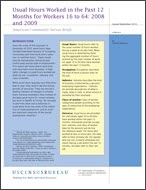
An official website of the United States government
Here’s how you know
Official websites use .gov
A .gov website belongs to an official government organization in the United States.
Secure .gov websites use HTTPS
A lock (
) or https:// means you’ve safely connected to the .gov website. Share sensitive information only on official, secure websites.
-
//
- Census.gov /
- Publications /
- Usual Hours Worked for Workers 16 to 64: 2008 and 2009
Usual Hours Worked in the Past 12 Months for Workers 16 to 64: 2008 and 2009
Usual Hours Worked in the Past 12 Months for Workers 16 to 64: 2008 and 2009
Introduction
Since the onset of the recession in December of 2007, work hours have trended downward because of increasing involuntary part-time work and a reduction in overtime hours.1 These trends vary by metropolitan statistical area (metro area) and by type of employment.2 This report will show where work-hour cuts have been most prevalent. It highlights changes in usual hours worked per week by sex, occupation, industry, and class of worker.
While work hours typically vary little from year to year, they tend to decline during periods of recession. They can also be a leading indicator of changes in employment, because employers may increase or decrease work hours for current employees prior to layoffs or hiring.3 An increase in part-time work and a reduction in usual work hours are some of the indicators of underemployment, and as such, are important measures of the overall employment situation.4
__________
1 Bureau of Labor Statistics. 2009. “The Employment Situation: January 2009.” Available online at <www.bls.gov/news.release/archives/empsit_02062009.pdf>.
2 For more information on metropolitan statistical areas please see <www.whitehouse.gov/omb/assets/omb/bulletins/fy2009/09-01.pdf>.
3 Bureau of Labor Statistics. 2008. “Involuntary Part-Time Work on the Rise.” Issues in Labor Statistics, December 2008.
4 Underemployed individuals are those who wanted full-time jobs but worked less than 35 hours per week due to slack work (a reduction in hours in response to unfavorable business conditions) or because they were only able to fi nd part-time work.
Others in Series
Publication
Publication
Publication
Share
Related Information
Some content on this site is available in several different electronic formats. Some of the files may require a plug-in or additional software to view.
 Yes
Yes
 No
NoComments or suggestions?


Top

